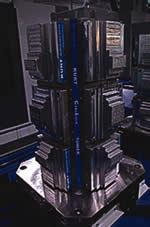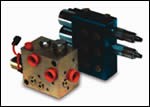Workholding System Uses Stepped Jaws To
The Integrated Hydraulics division of Parker Hannifin Corporation is a manufacturer of hydraulic cartridge products and integrated systems used in fluid power applications.
Share







Autodesk, Inc.
Featured Content
View More

Hwacheon Machinery America, Inc.
Featured Content
View More


The Integrated Hydraulics division of Parker Hannifin Corporation (Chanhassen, Minnesota) is a manufacturer of hydraulic cartridge products and integrated systems used in fluid power applications. The hydraulic manifold blocks for these products require precision machining, which is done on two horizontal machining centers (HMCs) equipped with a series of CarvLock cluster towers from Kurt Manufacturing Company (Minneapolis, Minnesota).
To maximize productivity for its diverse product mix, Parker Hydraulics uses a well-planned high density Kurt workholding system that accommodates many different size manifold blocks in relatively small production runs. Manufactured out of 11L17 and 12L14 steel, ductile iron and aluminum, these manifold blocks are finish machined in several sizes with various configurations of SAE ports, valve cavities and threaded holes, most with precision features. The manifold blocks range in size from 1-inch to 15-inch widths, and lot sizes average around 100.
“Our workholding setup allows us to maximize the output potential of our Palletech system while it provides us with the flexibility needed to handle the many different size manifold blocks for our product mix,” reports Rick Vogel, manufacturing supervisor for Parker Hydraulics. “We have ten towers in the system, with each tower holding eight parts for machining. There are two clamping stations per tower face, and each station is equipped with stepped clamping jaws. The center stationary jaw is also stepped to match up and provide the correct clamping dimensions for up to 15 different size manifold blocks. By rotating the jaws in each station, we cover the full range of needed sizes from smallest to largest without having to change jaws.”
The biggest advantage to the setup, according to Mr. Vogel, is that it allows for machining on three sides of the part without having to unclamp, reposition and reclamp the part. Steps on the two non-clamping sides of the jaws provide the needed clearance to do the required machining on three sides of the part without having to change the jaws. The stepped jaw design reduces spindle travel so that the system is in the cut at all times, delivering maximum productivity.
Getting the most out of a system like the HMC-equipped Palletech system is described by Mr. Vogel as amazing to see in action. Parker Hydraulics uses both to mill, drill, tap and bore. Both HMCs have a top speed of 12,000 rpm with a chip-to-chip tool change time of 3 seconds.
Parker Hydraulics requires close tolerances for its hydraulic blocks, which means the clamping system has to be extremely rigid. The cluster towers are precision machined from 80,000 psi ductile iron which is said to give the clamping modules the extra rigidity needed to achieve workpiece immobility while damping cutter induced vibration.
With four different jaw systems available for these cluster towers, Mr. Vogel and his team opted for the machinable aluminum design for five of the towers and machinable ductile iron for the second set of five towers. This combination is said to provide the best clamping force for different size manifold blocks with the largest sizes held in ductile iron jaws and the smaller ones held in aluminum jaws. By using Kurt’s off-the-shelf jaws, Mr. Vogel and his team saved time over designing their own. The quick-change feature allows removing and repositioning a set of three jaws in about a minute, which is done while the towers are in the setup queue. These movable and stationary jaws repeat to 0.001-inch accuracy, so there are no alignment problems when changing the jaw setup. Another feature Mr. Vogel and his operators like is that the center clamping area of the CarvLock towers are covered at all times, so chips and debris are kept out of the clamping mechanism.
Where lot size requirements for the manifold blocks exceed 200 and are machined from 11L17 and 12L14 steel and ductile iron, Mr. Vogel and his team use another high density cluster tower on the HMC. With 12 clamping stations (three per side with potential for four on smaller manifold blocks), this tower setup employs a clamping module called the WedgeLock. The WedgeLock has a serrated bottom which interlocks with serrations on the tower surface.
The advantage of this design is that it is self-aligning. The serrations on these mating surfaces are precisely machined to provide 0.062-inch indexing between surfaces. When these opposing serrations come together, they interlock forming a rigid, level and highly repeatable interface. Matching serrations automatically align the surfaces, making subsequent reclampings highly repeatable. Various size parts can be clamped quickly and accurately, similar to a custom fixture, but with the versatility of a modular system. High density is also the key in this workholding setup because three parts are clamped closely together on each tower face, reducing spindle travel to a minimum. Accuracy to ± 0.001 inch is held on these parts for milling, drilling and tapping at speeds to 1,700 rpm.
“This workholding setup is a nice complement to the tower setup on our Palletech system because it gives us versatility in machining various size manifold blocks in hard materials and in larger quantities” reports Mr. Vogel. “We also get the output we need in a single machining center.”
Read Next
5 Rules of Thumb for Buying CNC Machine Tools
Use these tips to carefully plan your machine tool purchases and to avoid regretting your decision later.
Read MoreSetting Up the Building Blocks for a Digital Factory
Woodward Inc. spent over a year developing an API to connect machines to its digital factory. Caron Engineering’s MiConnect has cut most of this process while also granting the shop greater access to machine information.
Read MoreBuilding Out a Foundation for Student Machinists
Autodesk and Haas have teamed up to produce an introductory course for students that covers the basics of CAD, CAM and CNC while providing them with a portfolio part.
Read More




































.jpg;maxWidth=300;quality=90)





.jpg;maxWidth=970;quality=90)